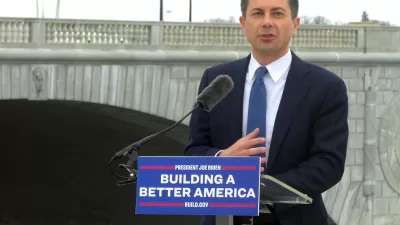Some skepticism is warranted about the potential impact of a proposed federal rule for states and regional planning agencies to track greenhouse gas reductions from transportation investment.

The U.S. Department of Transportation’s Federal Highway Administration (FHWA) announced a Notice of Proposed Rulemaking (NPRM) for states and municipalities to track and reduce greenhouse gas (GHG) emissions,” according to a press release published on the FHWA website on July 7.
The proposed rule would piggyback on the $27 billion in federal funding from the Infrastructure Investment and Jobs Act (IIJA) to help state departments of transportation (DOTs) and metropolitan planning organizations (MPOs) meet GHG reduction targets.
The specifics of the proposed rule are twofold, according to the press release:
- Establish a national framework for tracking state-by-state progress by adding a new GHG performance management measure to the existing FHWA national performance measures to help states track performance and make more informed investment decisions.
- Create a flexible system under which State DOTs and MPOs would set their own declining targets for on-road greenhouse gas emissions from roadway travel on the National Highway System.
The press release also lists programs funded by the IIJA intended to reduce emissions, including the Carbon Reduction Program, the National Electric Vehicle Infrastructure (NEVI) Formula Program, the Discretionary Grant Program for Charging and Fueling Infrastructure, Congestion Relief Program, Reduction of Truck Emissions at Port Facilities Program, Low or No Emission Vehicle Program, Transportation Alternatives Set-Aside, and the Transit Oriented Development (TOD) Program. Some of these programs are likely to be more effective than others at reducing emissions rather than scoring public relations points.
“This is a vital first step, but there is still more the administration can and should do. We urge the USDOT to be bold and consider state progress on these new emissions goals when awarding discretionary grant funding, particularly for projects related to emissions reduction like the Carbon Reduction Program,” said Beth Osborne, director of the Transportation for America advocacy organization, in response to the proposed rule.
Corinne Kisner, executive director of the National Association of City Transportation Officials (NACTO), and Janette Sadik-Khan, chair of NACTO, also released a statement praising the Biden administration for the proposed rule. “We can’t change what we don’t measure,” said Janette Sadik-Khan.
As noted in the FHWA press release, transportation is currently the largest source of emissions in the United States.
Despite the obvious negative externalities of automobile dependency, most states prefer car-centric infrastructure investments. The proposed rule was announced, for example, the same week that Arizona Governor Doug Ducey vetoed a proposed ballot initiative in Maricopa County that would have extended the Proposition 400 transportation sales tax to fund 350 new freeway and highway lane miles, including 186 new HOV lane miles, and 1,300 new or improved arterial road lanes. Gov. Ducey vetoed the initiative due to concerns about raising taxes during a period of intense inflation—not out of concern for greenhouse gas emissions in a region facing intense climate risks.

Study: Maui’s Plan to Convert Vacation Rentals to Long-Term Housing Could Cause Nearly $1 Billion Economic Loss
The plan would reduce visitor accommodation by 25,% resulting in 1,900 jobs lost.

North Texas Transit Leaders Tout Benefits of TOD for Growing Region
At a summit focused on transit-oriented development, policymakers discussed how North Texas’ expanded light rail system can serve as a tool for economic growth.

Why Should We Subsidize Public Transportation?
Many public transit agencies face financial stress due to rising costs, declining fare revenue, and declining subsidies. Transit advocates must provide a strong business case for increasing public transit funding.

How to Make US Trains Faster
Changes to boarding platforms and a switch to electric trains could improve U.S. passenger rail service without the added cost of high-speed rail.

Columbia’s Revitalized ‘Loop’ Is a Hub for Local Entrepreneurs
A focus on small businesses is helping a commercial corridor in Columbia, Missouri thrive.

Invasive Insect Threatens Minnesota’s Ash Forests
The Emerald Ash Borer is a rapidly spreading invasive pest threatening Minnesota’s ash trees, and homeowners are encouraged to plant diverse replacement species, avoid moving ash firewood, and monitor for signs of infestation.
Urban Design for Planners 1: Software Tools
This six-course series explores essential urban design concepts using open source software and equips planners with the tools they need to participate fully in the urban design process.
Planning for Universal Design
Learn the tools for implementing Universal Design in planning regulations.
City of Santa Clarita
Ascent Environmental
Institute for Housing and Urban Development Studies (IHS)
City of Grandview
Harvard GSD Executive Education
Toledo-Lucas County Plan Commissions
Salt Lake City
NYU Wagner Graduate School of Public Service





























